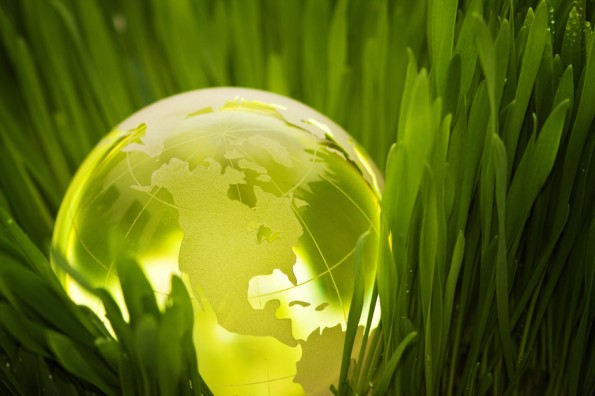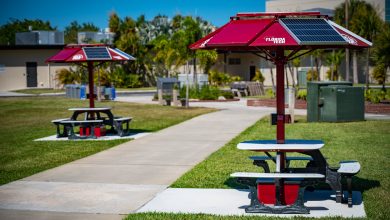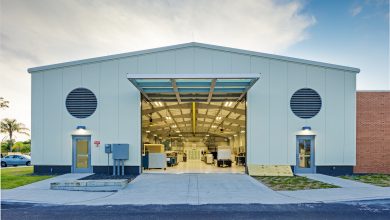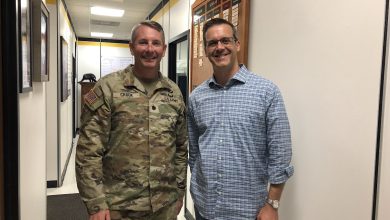Energy Challenge Has Students Seeing Green
Americans produce over 15 trillion pounds of carbon dioxide (CO2) every year. But at Florida Tech, students saved more than 117,000 pounds of CO2 from entering the atmosphere last year, through the Live Green Energy Challenge.
The challenge was devised when Daniel Sutton, the university’s sustainability officer joined forces with graduate students from the interdisciplinary sciences program – Zach Eichholz and Alexis Miller. Together they brainstormed a way to bring sustainability issues to the attention of residents.

Eichholz is the residence director of the dorm quad consisting of Campbell, Shaw, Wood and Grissom Halls. Miller is the residence director for Roberts Hall.
So they formulated a plan for a little friendly competition between residence halls. The goal was to see which hall could conserve the most energy.
According to the Environmental Protection Agency , electricity generation is the biggest contributor of greenhouse gas emissions in the United States.
The Live Green Energy Challenge was instituted for the first time in the fall 2016 semester, pairing Wood and Campbell up against Roberts.
The challenge was a joint collaboration between FIT Facilities, the Residence Life Sustainability Committee, and the Department of Education and Interdisciplinary Studies.
“We wanted to engage the students on day one here at FIT which is why we distributed the University Sustainability Guide to all on-campus students and made digital copies available to all other campus stakeholders,” Sutton said. “The idea surrounding this academic year was to raise awareness on sustainability issues across campus.”
Let the energy challenge begin
Residents were given tips for energy conservation and asked to incorporate them in their daily lives.
“The challenge is simply meant to try and reduce the amount of electricity being used by residence halls each month over the course of a semester when compared to the previous semester’s usage stats,” Eichholz said. “Reducing electricity also helps to reduce the amount of climate change inducing greenhouse gases released by the university. The primary one being carbon dioxide.”
Many residents didn’t know that a game console can consume 20 times more energy to stream a movie than a computer. They learned that enabling the “sleep mode” feature on a computer uses less energy during periods of inactivity. And an LED bulb uses up to 85-percent less energy to deliver the same amount of light.
Soon residents were preparing community dinners to reduce energy consumption. And it became second nature to turn off the lights when leaving a room.
And the winner is…
In the challenge’s first semester, the residence quad won (Wood and Campbell Halls) over the solo Roberts Hall. But combined all three halls saved 75,000 kilowatt hours of electricity compared to fall 2015.
“That is equivalent to saving over 117,000 pounds of carbon dioxide that would otherwise be released into the atmosphere,” Eichholz said. “And 75,000 kilowatt hours is the equivalent of the energy needed to power 8 average-sized American homes for an entire year.”
Plaques will soon be installed in Campbell and Wood Halls in honor of being the first winners of the challenge. Also, larger plaque will be erected in Evans Student Center that will showcase future residence hall winners.
“The goal was to promote sustainable efforts across campus,” Sutton said. “Now we have a great visible indicator of those efforts and the student’s positive impacts.
According to Eichholz, there was no resistance to the program. The residents were very receptive of the challenge – often stopping him to ask about the latest stats.
A larger challenge that includes all campus residence halls is set to begin in fall 2017.
“I think it’s a great program to give students a look at the differences they can make on their campus.” Miller said. “Sustainability isn’t just one person saving the entire world. It can be the mindfulness of an individual or a group. It’s people who want to make our little corner of the world just a bit better, healthier, happier. It’s the understanding that our actions can have repercussions elsewhere and for a long time.”
%CODE1SUSTAINABILITY%





